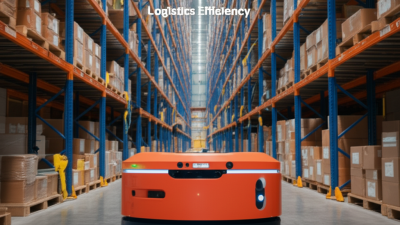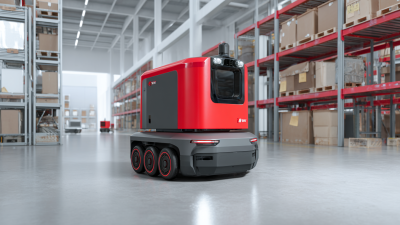Taking Custom Design to New Levels
PROUD TO BE PART OF THE BRIN FAMILY OF COMPANIES

OTHER BRIN LOCATIONS
Brin Glass Company | Minneapolis, MN
St. Germain’s Glass | Duluth, MN
Heartland Glass | Waite Park, MN
The logistics sector is undergoing a transformative shift with the integration of Automated Guided Vehicle (AGV) robots, significantly enhancing warehouse efficiency. According to a report by the Logistics Management Association, companies that implement AGV systems can increase operational efficiency by up to 30%, reducing labor costs and minimizing human error in material handling processes. Furthermore, a study by Grand View Research indicates that the global AGV market is expected to reach $7.1 billion by 2025, driven by the rising demand for automation in warehouses. As these intelligent vehicles navigate through complex warehouse environments, they contribute not only to faster throughput but also to improved safety and inventory accuracy. Understanding the impact of AGV robots in logistics is crucial for companies aiming to stay competitive in an increasingly automated industry.

The rise of Automated Guided Vehicles (AGVs) and Automated Mobile Robots (AMRs) is reshaping modern warehousing and logistics. Recent industry reports indicate a significant shift from fixed automation systems to mobile robotics, with the global market for AGVs projected to reach approximately $20 billion by 2027, growing at a CAGR of over 15% from 2020. This transformative trend enhances material handling efficiency, particularly in logistics facilities, where the ability of robots to navigate dynamic environments is crucial.
As AGVs and AMRs become more prevalent, they not only boost productivity but also address the workforce challenges faced by many businesses. Innovative robotic solutions contribute to improved labor productivity by up to 30%, significantly reducing human error and increasing operational speed. Furthermore, policymakers are encouraged to support the adoption of these automated technologies to enhance worker safety and ensure supply chain resilience, particularly in times of increased demand or labor shortages. The automated warehouse of the future promises a seamless integration of human and robotic capabilities, creating an agile and efficient environment that meets the modern challenges of logistics management.
Automated Guided Vehicles (AGVs) have become pivotal in enhancing operational efficiency within warehouses. According to a study by the Logistics Management Institute, implementing AGVs can increase warehouse productivity by up to 30%, significantly reducing the time spent on material handling and transportation tasks. This efficiency not only leads to faster order fulfillment but also reduces labor costs by minimizing manual interventions in repetitive tasks.
Tips for optimizing AGV use include ensuring proper route planning to minimize travel distances, which can improve cycle times. Additionally, regular maintenance of AGVs is essential to prevent downtime and ensure that they are operating at peak performance. Businesses should also consider integrating AGVs with warehouse management systems for real-time data tracking and inventory management, which can further enhance logistical operations.
Incorporating AGVs in warehouse processes provides a scalable solution that adjusts to fluctuating demands efficiently. A report from IDC indicated that companies using AGVs experience a 20% reduction in operational costs over time, underscoring the long-term financial benefits of this technology in logistics. Embracing AGVs is not just a trend; it is a strategic move towards a smarter and more efficient warehouse operation.
As the logistics landscape undergoes significant transformation, Automated Guided Vehicles (AGVs) have emerged as a critical innovation in enhancing warehouse operations. By streamlining material handling and reducing manual labor, AGVs contribute to substantial cost savings for logistics providers. Their ability to operate continuously without breaks not only improves productivity but also minimizes errors associated with human intervention. As a result, companies are increasingly integrating AGV systems into their warehouses to capitalize on these efficiency gains.
The financial implications of adopting AGV technology are noteworthy. A recent survey highlights that the majority of global shippers and logistics providers are ramping up their technology investments, signaling a strong belief in the return on investment (ROI) that AGVs offer. These robots optimize space utilization and ensure faster order fulfillment, which directly impacts logistics budgets. By analyzing the long-term cost benefits against initial implementation costs, organizations can better evaluate how AGVs contribute to overall profitability and operational resilience in a competitive market.
The implementation of Automated Guided Vehicles (AGVs) in warehouse environments has marked a significant shift in logistics efficiency. By employing AGVs, companies are not only streamlining their operations but also drastically reducing labor costs and minimizing human error. Case studies have shown that businesses that have integrated AGV technology report enhanced inventory management and faster order fulfillment rates. This demonstrates the profound impact AGVs can have in revolutionizing warehouse processes.
**Tips:** When considering AGV implementation, start with a thorough analysis of your warehouse layout and workflows. Identify areas where AGVs can provide the most significant benefit, such as high-traffic picking zones or heavy lifting tasks. Additionally, consider engaging with system integrators who specialize in AGV technology to tailor a solution that meets your specific needs.
Moreover, as the logistics industry embraces the Fourth Industrial Revolution, staying updated on new robotics advancements is crucial. The successful deployment of AGVs not only hinges on the technology itself but also on continuous training and adaptation of the workforce to ensure seamless integration. Companies that invest in employee training and change management strategies will likely see the most successful outcomes with AGV implementation in their warehouses.
This chart illustrates the efficiency improvements observed in warehouse environments after the implementation of Automated Guided Vehicles (AGVs). Data shows percentage increases in various logistics metrics over a year:
Automated Guided Vehicles (AGVs) are set to reshape the future of logistics and supply chain management significantly. According to a recent report by Fortune Business Insights, the global AGV market size is expected to reach $6.98 billion by 2028, growing at a CAGR of 16.5% from 2021. This surge highlights the increasing demand for automation in efficient warehouse management as companies seek to minimize labor costs and throughput times.
One of the pivotal trends in logistics influenced by AGVs is the enhancement of inventory management. AGVs can facilitate real-time tracking and optimization of stock levels, which aligns with a study from McKinsey indicating that companies implementing AGVs have seen a 20% to 30% increase in inventory accuracy. Furthermore, as AGVs become more integrated with AI and IoT technologies, they can autonomously navigate complex warehouse environments, reducing the one-time logistical strain while improving overall operational resilience. This evolution not only improves efficiency but also elevates the capability of businesses to respond to changing market demands swiftly.






Taking Custom Design to New Levels

Brin Glass Company | Minneapolis, MN
St. Germain’s Glass | Duluth, MN
Heartland Glass | Waite Park, MN

Fabricator
Inside Sales and Client Support Manager
Glass Handler – 1st Shift